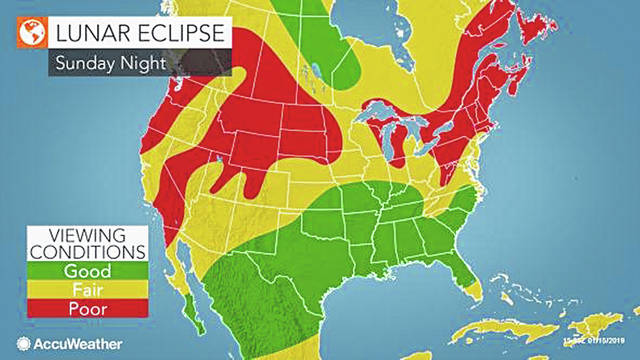
AccuWeather Global Weather Center — The moon will turn red over the United States, Sunday night, Jan. 20, during the last total lunar eclipse of the decade.
A total lunar eclipse occurs during a full moon when the moon passes directly through the Earth’s shadow, causing it to turn rusty orange or dark red in color.
The lunar eclipse will be visible across all of North America and South America, and partially visible in Europe and Africa, on the night of Jan. 20 into the early hours of Jan. 21.
This will be the first total lunar eclipse visible in its entirety across the U.S. since Dec. 21, 2010.
The best viewing conditions are expected across a swath of the central and southwestern U.S where it will be mainly cloud-free.
“It’s going to be very cold with temperatures in the single digits and teens F in parts of the Midwest and Plains,” AccuWeather Meteorologist Mike Doll said, so people will need to bundle up when heading outside to look at the moon.
Areas along the East Coast from Boston through Miami may not be able to see the celestial light show due to widespread clouds.
“There is a potential for a major winter storm to impact the mid-Atlantic and Northeast [this] weekend and could last into Sunday night. If that happens, viewing the lunar eclipse is a no-go for residents in those regions,” Doll said.
Doll also expects clouds over much of the Pacific Northwest, but there could be enough breaks in the clouds over the northern Plains for residents in Minneapolis and Denver to see the unusual red moon.
Folks planning to see the moon turn red will need to stay up late on Sunday night as the eclipse will not reach its peak until just before midnight.
The first phase of the eclipse, known as the penumbral phase, will begin at 9:36 p.m. EST. However, the moon may not become noticeably darker until the partial phase of the eclipse begins at 10:34 p.m. EST.
The most-anticipated part of the eclipse, totality, will begin just before midnight and last for around an hour as the moon passes through Earth’s innermost shadow. This is when the moon will turn rusty orange or red in color.
The total eclipse is set to end around 12:43 a.m. EST, after which, the moon will gradually regain its normal color.
Those who miss this eclipse will need to wait until May 26, 2021 for the next opportunity to witness a total lunar eclipse.
Sunday night’s total lunar eclipse will appear similar to those in the past, but has been given the unofficial nickname of the “super blood wolf moon.”
“Although it’s a bit of a silly-sounding name, it does have a basis in some real phenomena,” said Caleb Scharf, director of astrobiology at Columbia University.
The term, “blood moon,” has emerged in recent years due to the color the moon turns during the height of a total lunar eclipse.
“‘Blood moon’ is not a term used in astronomy. It’s more of a popular phrase, perhaps because it sounds so dramatic. It simply refers to a ‘total lunar eclipse,’” according to the Old Farmer’s Almanac website.
This eclipse also falls during the first supermoon of 2019 when the moon appears slightly larger than normal.
Preceding the terms, “supermoon” and “blood moon,” a full wolf moon is simply the name bestowed upon January’s full moon.
“In Native American and early Colonial times, the full moon for January was called the full wolf moon. It appeared when wolves howled in hunger outside the villages,” the Old Farmer’s Almanac reported.
These three terms have been combined to form a long-winded nickname for the upcoming lunar eclipse.
No special equipment or glasses are needed to view the lunar eclipse, but people may want to bundle up when stepping outside on the chilly January night.
“A pair of basic binoculars would be fun. You’ll definitely get more out of the experience,” Scharf said.
Binoculars or a telescope will reveal more details on the moon’s surface, such as smaller craters speckled across its surface.
The eclipse will also bring a window for photographers to take breathtaking pictures of the night sky, as the eclipsed moon will greatly reduce the amount of natural light pollution filling the sky.
The darkened sky will also make it easier to spot some stray shooting stars.
Stargazers staying awake after the eclipse is over will also be able to see an astronomical event known as a conjunction.
Venus and Jupiter will appear side-by-side in the southeastern sky between 5 a.m. and sunrise. These planets will be hard to miss, as they are the brightest planets in the night sky.


